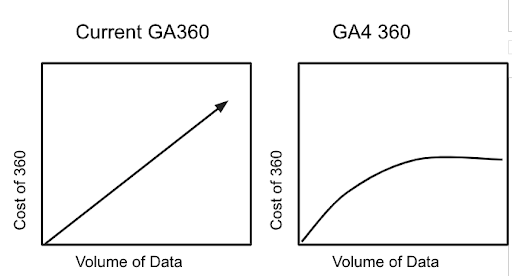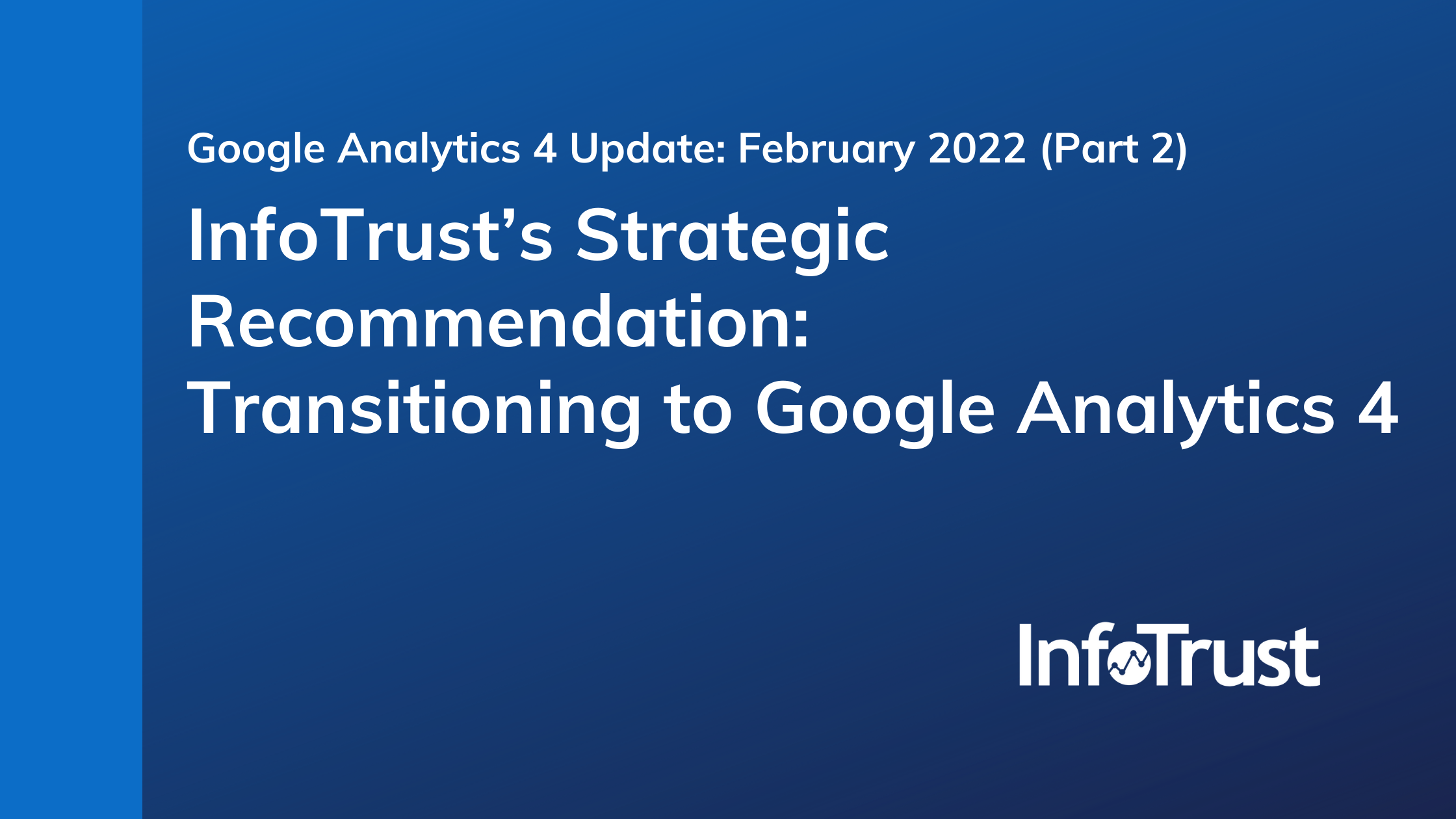As a follow-up to our Google Analytics 4 (GA4) February 2022 update, in which we cover some key features of GA4 and address whether your business should begin its analytics transition (the answer is yes, if it hasn’t already), we would like to offer more depth on our recommendation, as well as suggestions for transitioning into the future of marketing and analytics with GA4. Our recommendation addresses the transition from Universal Analytics (UA) to GA4 in light of UA’s sunsetting in the near future, while accounting for GA4’s current gap in full-feature parity as well as pricing advantages.
Recommendation
Our strategic recommendation for most organizations during this transition period is to continue to dual-tag with UA/GA4, and while GA4 feature parity is being achieved, implement the new GA4 features as they are rolled out. This holds true unless the current state of GA4 already solves for your business needs—in which case, consider making a move to GA4 sooner, given the GA4 Enterprise pricing model cost benefits.
For clarity, we distill the above recommendation into its main components—dual-tagging, feature parity, and the GA4 pricing model—and offer a brief description of each.
Dual-Tagging
This approach implies continuing to use UA, and simultaneously and incrementally implementing GA4 across your assets. Two major benefits that GA4 offers in this respect are:
1. Implementation: It is very easy to implement at a basic level—GA4 tags are readily available in Google Tag Manager (GTM)
2. Enhanced measurement tracking: GA4 includes some key user event tracking capabilities out-of-the-box—meaning that organizations can track user actions such as scrolls, site searches, video engagement, and file downloads almost as easily as pageviews—without adding any extra code. This enhanced measurement is an important point, since it will help companies to get quickly set up with more granular, user-centric data early on in their adoption.
By contrast, UA event tracking could require a datalayer implementation, GA, and GTM configuration; GA4 can much more readily capture this key user action data from the outset, quickly adding value to analysts and businesses with less implementation work.
These two aspects should help drive incremental adoption, because you don’t need to do a full-scale GA4 implementation right off the bat if you are dual-tagging. It is a great way to put time on your side. The point here is to drive progress—incremental progress—not perfection.
Feature Parity
As mentioned, GA4 does not currently have full-feature parity with UA (as of February 1, 2022); however, Google expects that several key parity features will be released within the next three to six months, with others coming later in 2022. Some of these include, for example, product-scoped dimensions, subproperties and roll-up properties, integrations, and export SLAs. Some organizations may require or greatly benefit from these features, in which case we suggest adding these incrementally into your existing GA4 use as they become available.
If the current state of GA4 meets your present and future business requirements, then we suggest switching to GA4 sooner rather than later, given the potential cost benefits associated with GA4’s pricing model.
In addition to the eventual phasing out of UA, the ease of getting set up with GA4 alongside UA, feature parity, and pricing benefits, we recommend getting started with GA4 soon so that stakeholders can get accustomed to the new interface and capabilities. Additionally, this will provide GA4 with more data to feed its ML models and build audiences, so that when your business is ready to switch over, it will be in a better position to leverage the tools and user insights.
GA4 Enterprise (360): Cost Implications
The GA4 Enterprise “360” version will have a similar cost model to the current GA360 one, which is based on volume of data processed; however, while GA360 currently uses a hit-based pricing model, GA4 will use an event-based pricing model. For apps using Firebase, this is the exact same thing—all hits in apps are considered events. For web, a hit can be a pageview or event and has less processing than GA4 events, which is the only form of network request sent by GA4.
In general, there will still be a tiered or incremental cost as more volume of data accumulates, but the key difference is that the GA4 model is not a flat linear increasing line like GA360 is today. This means that the greater volume of data you accumulate or as your business grows and online traffic increases, you are charged less per event. See the illustrative curves below for reference. The bottom line is that GA4 is designed to help your business grow, not be a greater burden as your business grows. If you are experiencing constant overages for high hit volumes in GA360 today or have lots of growth from your online traffic, it may be advantageous to consider GA4 360 for its scalability and flexible pricing tiers.

Dual-use clarification: What happens if I am currently using GA360, and decide to upgrade to GA4 360 today?
Technically, if you are using GA360 today, you can upgrade your GA4 properties to GA4 360 at no additional cost. Google will never “double” charge you for your GA360 license/properties (based on UA hits) and your GA4 properties (based on events). So if you have an active license for GA360 (Universal), you can upgrade your GA4 properties to 360 with no added cost, but still reap all the benefits of 360 such as SLAs and added features. Reference our comparison document here for more information.
Note that when you are ready to switch to GA4 360—which we recommend when your organization is fully leveraging the tool as your product of choice or source of truth—you can switch your license from GA360 to GA4 360 and retain GA360 upgraded properties for 90 days (as of February 1, 2022; subject to change by Google). Again, Google will not allow two licenses at the same time to retain both GA360 and GA4 360, but allow an overlap period of 360 features within GA360 before downgrading it to standard UA. This is why it’s important to ensure your organization is fully adopted using GA4 360 before switching the license.
As a business stakeholder, you may be asking: How will we know when we’re ready to fully transition to GA4?
A large part of our recommendation is based on a business’ current and future analytics requirements; to that end, here are some high-level considerations for businesses to review and begin measuring their own state of analytics readiness:
- Present: Examine your business’ current analytics implementation. Conduct a comprehensive audit and documentation of your current architecture and use of UA, across: data collection (custom dimensions, custom metrics, events, goals, audiences, data imports), reporting and analysis (custom reports, dashboards, standard reports), UA features (product integrations: search console, Ads, BiqQuery, CM360, etc; UA tag settings used).
- Future: Consider what analytics tools and data are needed moving forward in light of regulatory changes (e.g., privacy, cookie deprecation), MarTech integrations, shifts in consumer behavior, and availability of new analytics features. Based on a comparison of your current and future state, identify what is no longer needed, filter it out, and consider an “analytics reset” in order to keep a lean, organized, and scalable analytics setup.
- Adaptation of UA setup to GA4: Given the differences in the data models, you may conceptually adapt your current data collection to GA4—for example, shifting from session-based analysis to user-based analysis. Other items to consider: timing events, page performance metrics, session-scoped dimensions, metrics, bounce rate, goals as conversion events, etc.
- Mapping UA data and configuration to GA4 equivalents: Based on the results of the above adaptation, match UA data to GA4—e.g., custom dimensions, metrics, etc. to event parameters, and goals to conversions.
Next Steps
We hope that the above recommendation and strategic approach provide you with an overview of some of the principal aspects to consider as your organization defines its analytics roadmap into the future. While there are certainly several considerations to take into account with respect to this type of transition, our recommendation is to put time on your side by dual-tagging and carrying out an incremental transition onto GA4. You will put your business in a much stronger position for the future ahead.


